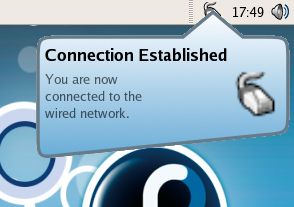
By Oliver Frommel
Like many of the major Linux distributions, Fedora never seems to keep on schedule. Following the lead of Ubuntu and Suse, Red Hat [1] postponed the release date for the next generation of Fedora, but the Fedora Core ISO images finally hit the mirrors on March 20.
Fedora Core 5 surprises users with some new artwork, including a bubbly design and the new Fedora logo: a symmetric "f" on top of a blue infinity sign. As the creators of this new Fedora logo explain, the "f" is embedded in a speech bubble representing the voice of the community. Stretching the metaphor, the "f" supposedly stands not only for Fedora, but also for freedom [2]. Some skeptics may see this attention to the symbolism of the logo as Red Hat's answer to the perceived lack of openness in the Fedora project itself.
Fedora's Anaconda installer gives users a GUI-based interface for a no-frills install that offers both conventional partitioning, and LVM-based logical volumes. If you are installing a desktop machine, and don't have a special reason to use LVM, you might prefer to turn this option down. From the user's viewpoint, very little has changed since the last Fedora. Behind the scenes, Anaconda reportedly comes with new Yum integration to resolve dependencies.
After the installer copies the packages to your hard disk, you'll still need to complete a few steps, such as setting up the firewall and SELinux, modifying the date and time, and testing your sound card. Previous Fedora releases can typically be updated to Core 5 without reinstalling.
After booting, a revamped Gnome Login Manager welcomes Fedora users. The developers seem to have sped up the login process. The default desktop in Fedora is now Gnome 2.14, but KDE fans can install version 3.5 of their favorite desktop.
New additions to the desktop include the Pup and Pirut package manager front-ends, although I am at a loss to say why Red Hat has included two new tools for a similar chore. Pup handles system updates, while Pirut focuses on installing and removing software in general. Both rely on the underlying Yum package management tool, which in turn relies on RPM.
A few months ago, the Fedora project caused a stir when they announced that Fedora Core 5 would include the Mono environment. Up to that point, Red Hat steered clear of Mono, a Microsoft .NET clone development mainly by Novell. Because of the Mono support built into Fedora Core 5, Fedora now comes with a number of popular Mono programs, including the simple but powerful note taking application Tomboy, which can export notes in various formats or publish notes directly in Weblogs. Additionally, Mono apps such as the Beagle desktop search engine and F-Spot, an application for digital photo management, are included in Fedora Core 5.
Red Hat tends to use Java for application development, and this explains why the distribution includes a huge amount of Java software development tools. Red Hat is heavily involved in the development of an alternative to the Sun JDK Java infrastructure, based on the GNU compiler, GCJ, and the GNU Classpath class libraries. Red Hat even provides native builds of the Java developer environment Eclipse and the Geronimo web application server for Fedora. If you also install Sun's JDK, you can toggle between Java versions using the alternatives command.
Fedora Core 5 comes with the latest version (4.1) of the GNU C Compilers, GCC, which Red Hat used to build the packages for the distribution. GCC 4.1 has new program optimization features, although it is not fully backwards compatible, so Fedora continues to offer the older GCC 3.2. Under the hood, you will discover a kernel 2.6.15 and Glibc 2.4.4. The hotplug system introduced just a short while back has been dropped, with Udev stepping in to provide drivers, device files, and hotplug support.
In the security stakes, Fedora again relies on SELinux, which is now slightly easier to manage thanks to the introduction of modular policies and the so-called Reference Policy. All programs have been compiled with a special feature enabled to make it difficult to exploit buffer overflows.
Like its predecessors, Fedora Core 5 has mediocre multimedia support. Although the distribution supports Xiph Codecs Ogg (audio) and Theora (video), it lacks MP3 and DVD support, but you can turn to the Livna repository [3] for the required libraries.
In spite of this general lack of attention to multimedia, the new Fedora does have one feature that should interest multimedia fans; Red Hat has been working on a hardware accelerated desktop for some time, with the aim of harnessing powerful 3D graphics adapters to support desktop effects such as transparency or shadowing. Red Hat's preferred approach is dubbed AIGLX (Accelerated Indirect GL X).
If you are interested in experimenting with AIGLX, you might want to start by checking the system requirements at [4]. As of this writing, AIGLX mainly supports ATI and Intel cards. Nvidia owners will have to wait for the next driver update.
AIGLX relies on the X server "drawing" window content in the invisible memory area. The Compositing Manager draws on the image data to compose the desktop, adding shadowing and transparency if required, and renders the whole figure on screen. As you would expect, all of this needs to happen multiple times per second to avoid spoiling the user experience with flicker or similar issues.
Fedora integrates compositing for AIGLX with the Metacity window manager. The feature is disabled by default, and will not work without a special X server, which - unfortunately - has not found its way to the normal Fedora repositories thus far. If you would like to use AIGLX, you will need to add a developer repository, as described at [4]. Then to install the package, enter the yum install xorg-x11-server-Xair command. In contrast to what the HOWTO tells you, the Metacity and GDM versions are now correct.
The configuration program is hidden in System | Administration | Login screen. Click on the security tab, and then press Configure X Server to open the required dialog. Then click Add/Edit to open a dialog where you can select the aiglx server. After selecting the aiglx server, you just need to tell Metacity to be your Compositing Manager. The Metacity configuration in the Gconf editor below /apps/metacity/general has a compositing_manager option that takes care of this. Then relaunch the X server to enable the AIGLX effects. Wobbling windows worked on our lab machine with a fairly ancient ATI Radeon 7000, although the speed leaves much to be desired.

Fedora Core 5 comes with few major surprises, but the new Fedora is a modern and stable distribution with the latest server and desktop software. Check out the "New Features" box for more details. Extensive Mono and Java support make Fedora Core 5 a good choice for system administrators and programmers.
| New Features |
|
Gnome 2.14, KDE 3.5, Web browser Firefox 1.5, OpenOffice 2.0, Xorg Release 7, Package Manager for front-ends Pup and Pirut, Compiler GCC 4.1, Kernel 2.5.16, C-Bibliothek Glibc 4.4, Foreign language input with SCIM, SE-Linux Reference Policy, Virtualization with Xen 3.0, Postgresql 8.1, MySQL 5.0 |
| INFO |
|
[1] Red Hat's Fedora Site: http://fedora.redhat.com
[2] Logo design process: http://www.capstrat.com/development/fedora [3] Livna RPMs: http://rpm.livna.org [4] Installing AIGLX: http://fedoraproject.org/wiki/RenderingProject/AiglxOnFedora |